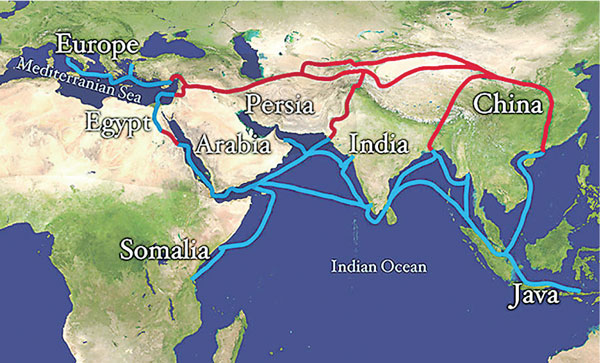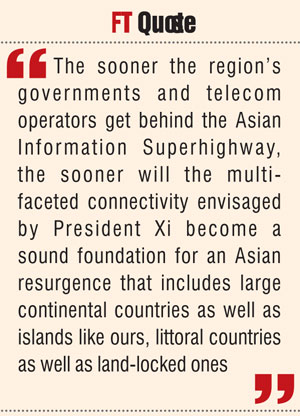
Wednesday, 26th November 2014
President Xi Jinping wants to recreate the Silk Road. The world will give him the credit, though Kazakhstan’s President Nazarbayev may have spoken of it earlier. Clearly, the Chinese Government is the prime mover behind this initiative.

Figure 1: The ancient Silk Road Source: NASA
Silk Road in history
The Silk Road was not known by that name when it was a functioning channel of commerce centuries ago. It was so named in 1877 by Baron Ferdinand von Richthofen, a geographer charged with laying out the trace for a rail road from the German concession in Shandong through the coal fields in Xi’an to Germany.

Subsequent research has shown that it was not the trunk route portrayed by Richthofen but a series of paths across deserts and mountains that connected China to various locations in Asia such as Samarkand (in today’s Uzbekistan) and India. It transported more than silk: cargo manifests included chemicals, spices, metals, saddles, leather products, glass and paper. It is the paper, preserved by the dry climate, that yielded many of the recent insights.
The nature and significance of the Silk Road is best illustrated by one who traversed it: the Scholar Monk Faxian (for whom Pahiyangala in the Kalutara District is named). Ven. Faxian (337-422 CE) arrived in India over the land-based Silk Road, visiting many sacred sites in what are now Xinjiang, China, Pakistan, India, Nepal, Bangladesh and Sri Lanka in 399-412 CE as described inA Record of Buddhist Kingdoms, Being an Account by the Chinese Monk Fa-Xian of his Travels in India and Ceylon in Search of the Buddhist Books of Discipline.
He is said to have arrived in Sri Lanka by ship from Tamralipti (an ancient port city along the Hooghly River in what is now West Bengal). After two years in Sri Lanka, he left for China by sea, including stops in Java. His account indicates regular movement of regular merchant vessels across the seas. This then, was part of the maritime Silk Road.
Ven. Faxian’s travels show us that the Silk Road was not only about connecting China to Europe; and that its users saw the land and sea components as interchangeable.
By land, and also by sea

The Silk Road should be re-imagined as a mesh that includes both land and sea components. This is already beginning, with IT manufacturers in central and western China making decisions on the comparative costs of shipping their products to Europe via the nascent China-Europe rail links relative to the longer, but cheaper, sea route through the Malacca Strait. The focus on Europe is understandable, given its relatively greater purchasing power at this time. But as the Asian markets grow, intra-Asian trade will take centre stage. As in the old days, the Silk Road, over land or by sea, is not without danger. Natural disasters may block transport. Unnatural disasters pose dangers too. Unpopulated spaces and extremist groups constitute a volatile mixture. Today, heavy security is provided to freight trains on the China-Europe run. Defences have been strengthened on ships in the Indian Ocean. But the best defence always includes redundancy of paths.
As in the days of Ven. Faxian, Sri Lanka has to be seen in its South Asian (or Indian) context. This little island is of little value to the maritime Silk Road unless it continues as an integral part of the logistics system of India. Disregarding India’s security concerns will relegate Sri Lanka to a refuelling stop and end its role as a logistics hub.
Goods, but knowledge too
Ven. Faxian was not a trader. He came to India and Sri Lanka for knowledge. So, it was not only goods that travelled on the overland and maritime Silk Roads.
Today, even if the focus is on goods, be they oil and gas across the Indian Ocean or laptops and tablets across Central Asia, it is not possible to ignore data, information and knowledge flows that accompany them. In the simplest form, it is the data streams, phone calls, emails that smoothen out the logistics chain. But the knowledge flows that stream across the internet are the most important.
It is noteworthy that Chinese telecom operators are already contributing to the ICT infrastructure that is essential to the realisation of the maritime component of the Silk Road. Even though the new submarine cables, SEA-ME-WE 5 and AAE-1, do not actually land on Chinese soil, both have significant investment from Chinese operators. AAE-1 will land in NgweSaung in Myanmar and connect to thealready operational terrestrial cable linking that beach resort to Nanning, a regional capital in South Western China and thereby to all of China.
The building up of undersea and terrestrial fibre optic cable capacity in the Indian Ocean region is good. But what is urgently needed is greater engagement by the governments and operators in the entire region in the ongoing efforts by UN Economic and Social Commission for the Asia Pacific (ESCAP) to build consensus around an open-access ‘Asian Information Superhighway’ as a resilient mesh that includes both undersea and terrestrial components.
It is possible to place security teams on trains and ships to thwart the attacks of extremists. But it is not practical to guard fibre optic cables, be they placed on the ocean floor or buried underground. Security precautions can be taken at vulnerable points such as where the cables come ashore, but that will not be enough. Cable landing stations can be hardened, but there is not much that one can do about a powerful earthquake snapping a cable. What is needed is redundancy, whereby any link that is severed can be routed around. A mesh network with land and sea components is the solution.
ESCAP has made the installation of conduits or cables along the interconnected transportation systems made up by the Asian Highway and the Trans-Asian Railway Network one of its priorities. The new Asian Infrastructure Investment Bank should fund terrestrial and undersea cable connectivity in tandem with road, rail and ocean connectivity.
The sooner the region’s governments and telecom operators get behind the Asian Information Superhighway, the sooner will the multi-faceted connectivity envisaged by President Xi become a sound foundation for an Asian resurgence that includes large continental countries as well as islands like ours, littoral countries as well as land-locked ones.
From : http://www.ft.lk/2014/11/26/reimagining-the-silk-road/




